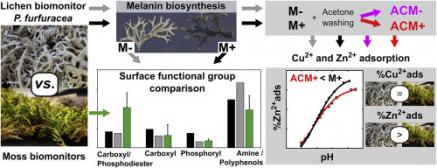- Home
- Dipartimento
- Ricerca
- Didattica
- Post Lauream
- Servizi e strumenti
- Trasferimento della conoscenza
Nuova pubblicazione - " Influenza dei metaboliti secondari sulla chimica di superficie e l'adsorbimento di metalli di un biomonitor lichenico devitalizzato"
Pubblicato sulla rivista Environmental Pollution dal gruppo di ricerca del prof. Mauro Tretiach
Tipologia news:
home
Breve Abstract in italiano
Il Iichene Pseudevernia furfuracea è spesso utilizzato nelle indagini di biomonitoraggio di elementi areodispersi. Tuttavia, le popolazioni native di questo biomonitor presentano una notevole variabilità del contenuto di melanine e sostanze licheniche, che sono dei metaboliti secondari di parete noti anche per la loro reattività chimica verso alcuni metalli. In questo lavoro è stato verificato se la presenza/assenza di questi metaboliti influenzi le proprietà anfotere di superficie e i processi di adsorbimento di Cu2+ e Zn2+. Si è osservato che la biosintesi di melanine aumenta il punto isoelettrico di superficie senza influenzare l'adsorbimento dei due metalli. La rimozione delle sostanze licheniche diminuisce solo l'adsorbimento dello Zn2+, e in modo trascurabile. Infine, per la prima volta, i dati relativi alle proprietà chimico-fisiche di superficie di un lichene modello vengono comparate con i risultati disponibili per i biomonitor muscicoli, dimostrando le ottime prestazioni garantite dal lichene.
Abstract
Despite the broad use of lichens as biomonitors of airborne trace elements, the surface chemistry and metal adsorption parameters of these organisms are still poorly known. The current investigation is aimed at (i) quantifying the acid-base surface properties and the first-order physical-chemical parameters of Cu2+ and Zn2+ adsorption of devitalized Pseudevernia furfuracea, a lichen commonly used in biomonitoring of airborne trace elements, and (ii) comparing the results with those available for moss biomonitors. Equilibrium constants and metal-binding site concentrations were calculated with a thermodynamic model by taking into account the presence/absence of ancillary extracellular cell wall compounds, namely melanin and acetone-soluble lichen substances. An acid–base titration experiment performed in the pH range of 3–10 showed that melanised and non-melanised P. furfuracea samples have lower pHPZC (3.53–3.99) and higher metal-binding site concentrations (0.96–1.20 mmol g−1) compared to that of the mosses investigated so far at the same experimental conditions. Melanin biosynthesis increased the content of carboxyl and phosphoryl groups and reduces that of amine/polyphenols. Cu2+ and Zn2+ adsorption was unaffected by the degree of melanisation while the removal of extracellular lichen substances slightly decreased Zn2+ adsorption. Although Cu2+ and Zn2+ adsorption parameters related to P. furfuracea surfaces were 3 times lower than in the mosses, lichen samples adsorbed the same amount of Cu2+ and 30% more Zn2+. The present study contributes in understanding the role of ancillary cell wall compounds in Cu2+ and Zn2+ adsorption in a model lichen. It also provides a first comparison between the surface physico-chemical characteristics of lichens and mosses frequently used as biomonitors of trace elements.
Abstract grafico

Ultimo aggiornamento: 27-01-2021 - 15:56



